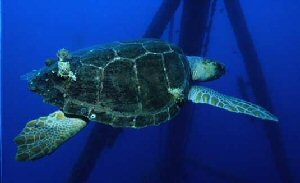Loggerhead Sea Turtle (Caretta caretta)

TPWD ©
- Texas Status
- Threatened
- U.S. Status
- Threatened, Listed 7/28/1978
- Description
- Loggerhead sea turtles have characteristically large heads with powerful jaws. Adults weigh 170 to 500 lbs. and have a shell up to 45 inches in length.
- Life History
- Although sea turtles are subject to predation throughout their life cycle, predation is particularly high during the first two years of life. Highest predation occurs during incubation and during the hatchlings' race to the sea. The eggs are eaten by ghost crabs, raccoons, skunks, foxes, and dogs. Hatchlings are preyed upon by mammals, sea birds, crabs, and carnivorous fishes. Predation continues to be high until the turtles are big enough to avoid being swallowed by large carnivorous fishes such as groupers, snappers, and jacks. Sharks are a formidable predator throughout the life cycle of sea turtles, although larger turtles can often avoid a shark attack by presenting the flat side of the plastron or carapace to prevent biting. Loggerhead sea turtles can live at least 30 years and up to 50 years or more.
Although feeding behavior may change with age, this species is carnivorous throughout its life. Hatchlings eat small animals living in seagrass mats which are often distributed along drift lines and eddies. Juveniles and adults show a wide variety of prey, mostly such as conchs, clams, crabs, horseshoe crabs, shrimps, sea urchins, sponges, fishes, squids, and octopuses. During migration through the open sea, loggerheads eat jellyfishes, pteropods, floating molluscs, floating egg clusters, squids, and flying fishes.
This is the only sea turtle that can nest successfully outside of the tropics, but the summer surface water temperature must be over 68 degrees Fahrenheit. As with other sea turtles, females return to lay their eggs on or near the same beach where they hatched. Unlike other sea turtles, courtship and mating usually do not take place near the nesting beach, but rather along the migration routes between feeding and breeding grounds. Females may nest several times during a breeding season (April - September), laying as many as 190 soft, round white eggs per nest. The eggs incubate in the sand for 55 to 62 days. The incubation period is longer when the weather is cool, and there is evidence that cooler incubation temperatures produce more male hatchlings. Hatchlings emerge from the nest mostly at night. After the majority of the hatchlings appear at the surface of the nest, they start a frenzied race toward the surf and out to sea.
Loggerhead hatchlings and juveniles are frequently associated with sea fronts (areas where ocean currents converge), downwellings, and eddies, where floating open ocean animals gather. The time that young turtles remain in these places feeding and growing is called the "lost year". During this period, young turtles float on rafts of seaweed with the currents, feeding on organisms associated with sargassum mats. - Habitat
- Loggerheads are capable of living in a variety of environments, such as in brackish waters of coastal lagoons, river mouths, and tropical and temperate waters above 50 degrees Fahrenheit.
- Distribution
- They are found worldwide. The major nesting beaches are located in the southeastern United States, primarily along the Atlantic coast of Florida, North Carolina, South Carolina, and Georgia. In Texas, they are found in the Gulf of Mexico and are occasional visitors to the Texas coast. Only minor and solitary nesting has been recorded along the coasts of the Gulf of Mexico.
- Other
- Until the 1970's, loggerhead turtles were commercially harvested for their meat, eggs, leather, and fat. Its meat and leather are not as valuable as the green sea turtle, and its shell is of less value than the hawksbill. However, in places where regulations are not enforced, the harvest of turtle meat and eggs remains a problem. Because of their feeding behavior and their habit of wintering in shallow waters, loggerheads, along with Kemp's Ridley sea turtles, are more likely to be caught and drowned in large shrimp trawl nets. Today, turtle excluder devices (TEDs) pulled by shrimp boats help reduce mortality from net entanglement by allowing turtles to escape from the nets.